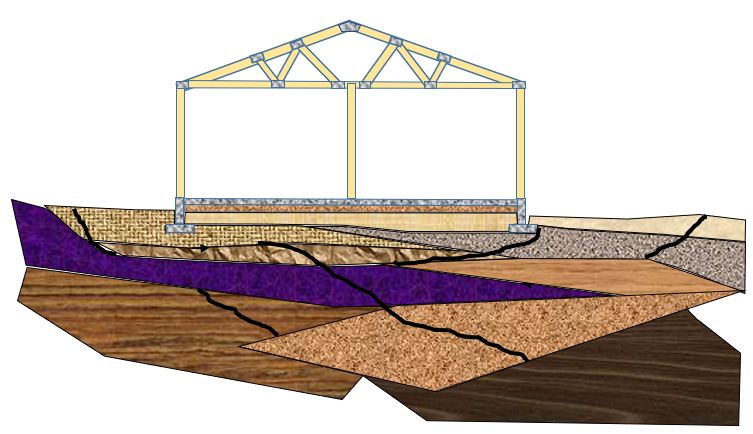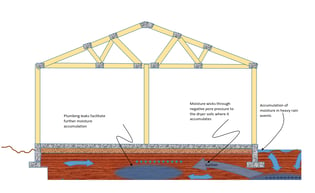I often hear people make statements about foundation movement that are not rooted in the reality of soil mechanics. Statements such as:
"My house is very old… I am sure it is done moving now."
"Water is making my house sink. If I put gutters on it will quit sinking."
"Cracks in exterior walls always mean my house is sinking."
"Vertical cracks in stem walls always mean my house is settling."
"Cracks and slopes in floor slabs always mean settlement."
"High spots in the middle of the slab are from the cantilevering as the footings settle."
I hear so called “experts” with 30 years of "experience", contractors who have been building homes for 30 years, homeowners with contractors or engineers as friends all without a clear understand of soil mechanics. Let's take each one of these statements and examine them further.
"My house is very old… I am sure it is done moving now". In fact, soil movement can occur at any age of a house.

The above is a depiction of a theoretical soil layer composition. Not unlike what could depict under a home. Each of the various layers depicted represent different compositions, clays, sand, silts each of varying combinations, different mineral compositions, some having natural cementation, some not. Each have varying densities from soft to hard. Each have varying moisture contents. Water moves between the various layers at different rates. Water affects the various layers in different ways. Collapsing some expanding others. Over time water invades different layers affecting them in different ways. There is no safe time when these things are not happening. Things can be very stable for a long period of time and as water makes its way to different layers over time they can seemingly start to move without apparent explanation.
Water is making my house sink. If I put gutters on it will quit sinking. In fact settlement is more commonly a result of shrinkage from dying clays than it is from consolidating sands or silts. So it is not only possible but likely that that by drying out the soil, that you may have the opposite effect that you are hoping for. Simple heuristic thinking is not always the most complete analysis of a complicated environment.
Cracks in exterior walls always mean my house is sinking. Cracks in exterior walls happen for a variety of reasons. Chief of which are thermal contraction and expansion. Others include improper lathing of the moisture layer among others. When it is lapped allowing water to run behind it, the stucco cracks. Modern stucco includes a ¾” layer of foam insulation. The nails holding the stucco netting to the frame pass through this layer of foam. When the frame of the house moves the nails bend and absorb the movement, hiding the movement of the frame. The drywall cracks on opposite side of the wall are a better indicator of wall (and hence footing movement). Not all wall movement is settlement. It is rare, but I have seen footing heave many times.
Vertical cracks in stem walls always mean my house is settling. Vertical stem wall cracks are often the result of the vertical J Bolt oxidizing. As it rusts, it grows in size putting tensile pressure on the concrete causing cracks. In addition, soil conditions cause minor movement of the stem wall in cyclic nature that often times results in little net movement, but can bring minor stresses to a long stem wall that cause minor cracking. Over many years, we have seen many minor cracks in stem walls that are proven with a floor level survey to not show any significant vertical movement of foundation system.
Cracks and slopes in floor slabs always mean settlement. I see so called experts pointing out 3 point cracks in floor slabs and opining that they indicate settlement of the footings in all or some directions. In fact a 3 point crack is a known and documented sign of floor slab heave. Soil typically can support 1500 lbs per square foot. 4” slabs weigh 50 lbs per square foot. Slabs typically don’t weigh enough to cause settlement by themselves. On the other hand, expansive pressure upward from expanding soils easily exceeds many times 50 lbs per square foot. Heaving especially in arid environments cracks and moves slabs far more often than settlement.
High spots in the middle of the slab are from the cantilevering as the footings settle. This one is quite amusing. A 4” unreinforced slab, can span 4 to 5 feet. For a slab in the middle of a home to be up from the downward movement of the perimeter would require slabs 15 inches thick with 1” diameter rebar (in both directions) in both top and bottom. So far we have not seen too many of these.
We often see concrete contractors or other construction “experts” espouse these heuristic types of claims, when they have never had any education in soil mechanics. Nor have they ever installed a single pile to correct foundation movement. They don’t have the experience of diagnosing with scientific methods foundation problems, and standing behind the recommendations from that diagnoses for 30 years after stabilizing and releveling with piles.
There is a reason why foundation Diagnoses should be done following a process designed by forensic geotechnical engineers and done under the supervision of licensed professional engineers. The process should be data driven and the recommendations transparently arrived at from that data. Anything less is a fairy tale.
For more information about expansive soil, click here!
For more information about Arizona Foundation Solutions, click here!
For more information on Ethical Foundation Inspections, click here!
For more information about foundation heave, click here!







